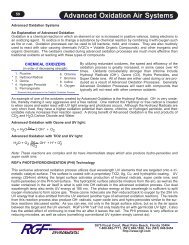You also want an ePaper? Increase the reach of your titles
YUMPU automatically turns print PDFs into web optimized ePapers that Google loves.
NorwalkH1N1Infectious DiseasesEffect on Indoor AirQualityBy Dr. James Marsden, Ronald G. Finkand Walter EllisStrep MRSAIndoor air quality (IAQ) is rapidly becoming a buzz word forthe HVAC contractor. Most people associate indoor air qualitywith air filtration, which is designed to remove airborneparticles. The problem is that standard air filters have little orno effect on microbials such as viruses and bacterial, ormolds, VOC, odors and other health-related air contaminants.IAQ got its start with the media rash of mold stories of the1980s. Odor control was the buzz word of the 1990s, andwith the fears of SARS, Bird Flu, Norwalk, MRSA and H1N1(Swine Flu), the 2000s will be the decades of infectious diseasesand control of bacteria and viruses.Major hotel chains, hospitals, cruise lines, schools/colleges,restaurant chains, property managers and major corporationsare developing infectious diseases contingency plans.It began with the Norwalk Virus on cruise ships and MRSAin hospitals. The SARS Virus in China, and now the widelyfeared H1N1 (Swine Flu). The concern is employee safety,negative publicity, and of course, legal liability.Most infectious disease contingency plans consist of themultiple interventions concept, which consists of the utilizationof multiple disinfection technologies and procedures.The cruise line industry had a serious problem with the NorwalkVirus a few years ago. Thousands of people were gettinginfected. Their plan included:• Rapid identification and isolation of the sick.• Continuous disinfecting of handrails, door knobs andbanisters.• Continuous UV disinfection of indoor air via the HVACducts.It was later discovered that standard HVAC UV systemswere not working as the dwell or contact time was not nearlylong enough. These were replaced with an Advanced Oxidationtechnology. The problem with any HVAC UV air disinfectionsystem is that the contaminated air has to travel along distance before the bacteria or viruses may or may notbe killed in the UV kill zone of the HVAC unit. Let’s say youhave a virus and you sneeze, anyone within six feet of youwill have been potentially exposed. The fact that the airbornevirus might or might not be killed in the UV air disinfectionsystem later is of no consequence. You have already beenexposed. This concept was discovered by Sandia NationalLabs while working with RGF Environmental Group on ahomeland security project for a potential terrorist bio attackon an airliner. In theory, a terrorist could aspirate a virus easily.No one would know until the next day after they havetraveled and spread the virus. This is how worldwide pandemicscan get started.The solution was to kill the virus at the source before itreaches another person. The problem was how do you dothat? RGF Environmental Group has been working with AdvancedOxidation technology since the mid-1980s. RGF’sPhotohydroionization or PHI technology looked promising ashaving the ability to kill an airborne virus within three feet.The next problem was how do you validate the results? Thevalidation had to be a double-blind in a bio test chamber andhad to be repeatable. Now, how do you duplicate a sneeze?No two people sneeze alike or not even the same personcould duplicate his or her own sneeze. A high-tech sneezemachine was needed. Of course, there was no such thing,so RGF developed one. When you sneeze, you evacuateone lung of air volume. You expel about one gram of fluid atabout 100 miles per hour. RGF invented and built the world’sfirst sneeze machine with controls for volume, fluid andspeed. Now it was possible to duplicate a sneeze allowing arepeatable method of testing the effectiveness of RGF’sAdvanced Oxidation technologies.3’88% ReductionKill rate of virus and bacteriaA PHI Cell creates an airborne plasma basically consisting offriendly oxidizers. Friendly being those found in nature thatreturn to oxygen and water after they oxidize, such as hydroperoxides.The process is like misting the air with an atomizedor very fine mist of hydrogen peroxide. A series oftests were conducted by Kansas State University, who alsoworks closely with Sandia National Labs. The first resultswere outstanding with a kill rate of 78% of a sneeze at threefeet. A more advanced cell was later developed by RGF,REME or Reflective Electro-Magnetic Energy, thationized the Advanced Oxidation plasmamaking it far more effective ona broader scope of contaminates.REME sneeze resultsshowed 88%RGF’s REME ® Cellreductions.During the SARS scare a fewyears ago, the Chinese Governmentinstalled PHI AdvancedOxidation Cells in city buses andsubways after determining it killedthe deadly SARS virus. A Chinesemanufacturer licensed PHITechnology for use on China’s buses and subways.It is a normal reaction to question the long-term safety of anyproduct that is effective and uses new or “breakthrough”











